Saturday, March 31, 2007
Projection Shutters
http://www.vshutter.com/
400 including shipping. Very lightweight (under a pound). pretty simple system with a shutter that covers the projector.
http://www.response-box.com/flapper.shtml
Slightly more expensive than the above product.
http://www.citytheatrical.com/la-dmxIris.htm#projector
from City Theatrical, much more expensive (775 list)
CAD Software
I am here today to introduce Napkin Cad http://www.napkincad.com/
Portable, fast, easy to distribute, and easy to use. What more can you ask for? You can download a PDF at the above site.
Materials Resource
Thursday, March 29, 2007
Additional Job Resource
It is educational in nature so positions are mostly for colleges, and they are for a variety of positions (history, technical, and so forth).
While I am speaking of jobs, i have been reading on Yahoo about job searching through blogs. Social networking is all over, and it seems to be more important to be connected. While some of this always occurred (conferences, list serves, forums and such), its a different game. While I think blogs are useful (otherwise why would I write...), they don't replace real news, and I think care needs to be taken about the validity of the information that you read. This is really true for the Internet as a whole, but as more and more people post, create websites, blog and otherwise disseminate information (Wikipedia...) its important to take a look at where the information comes from, whether or not it has face validity (does it seem to make sense), and if there are resources sited, or credentials to demonstrate some authority. While I don;t mean to get sidetracked, I think these issues become a step more complex when you start using these sources as a way to move ahead in your career.
For instance, MySpace now has a number of theatrical companies listed. I think this is good for the site as it is good publicity, and it tunes them into a generally younger audience. however, who is posting for the company? It is a person authorized by the company to display the site or is it someone who works there that took some initiative. If you comment on their site, will that really make you more hire-able to them, or will they not even notice. Secondly, if a person blogs in the name of a company (with or without consent) what is appropriate? How much can you tell about a specific process? I think about some of these issues even when writing this blog. I want to be sensitive about others intellectual property, their privacy and such. And I think there are some very fine lines between discussing issues relevant to technical theatre that are also touchy subjects that can be sensitive. Second, if you rely on a casual site to network, then they will have access to your casual site as well. I use myspace, and I enjoy the site. But for me that site is for those who know me personally, who are interested in photos of my last vacation, or my pets, and don't feel the need to see what I am doing professionally. And for me, that idea would make me weary of specifically trying to network through myspace for jobs. Though I suppose I could create a "professional" site.
However, there are other sites to consider as well. Note that I am avoiding facebook, and all of the other MySpace like services. Linked in is one http://www.linkedin.com/ . This site is geared to be a professional network. Also there is JigSaw http://www.jigsaw.com . There seem to be some important differences. Linked in you choose to participate, and have your information posted in a similar vain to MySpace. Jigsaw however, you can be put into the system without your own awareness. You can points by entering accurate names, positions, and contact information. I could go there and enter my address book and gain X number of points. If I put in inaccurate information someone could challenge me and I would lose points if the information was indeed incorrect (there is a time limit though, as over time it is reasonable that some people will move on). I could then use my points to "purchase" contact information and names of people that I may want to have for business or hiring purposes. You can also outright purchase names. Because of this, I am not as sure about joining Jigsaw. I am uncomfortable about putting my contacts information out publicly, first, but second, it seems as though it would be very easy to misrepresent your company using the site. but as always, these are my thoughts, and I encourage you to explore the sites, and decide for yourself. And, if you want- come back and comment and share your thoughts as well.
Adhesive Resource
Saturday, March 24, 2007
Grand Opera House
Led by Dr. Felcia Hardison Londre, a group of UMKC theatre students explored the now empty building. This landmark is in such a state of deterioration that it is slated to be torn down.

In the below picture you can see some of the class gathered around a section of brick. This area of brick is where we suspect that the proscenium wall joined the exterior brick. the next picture is of the steelwork that would have spanned and supported the proscenium opening.

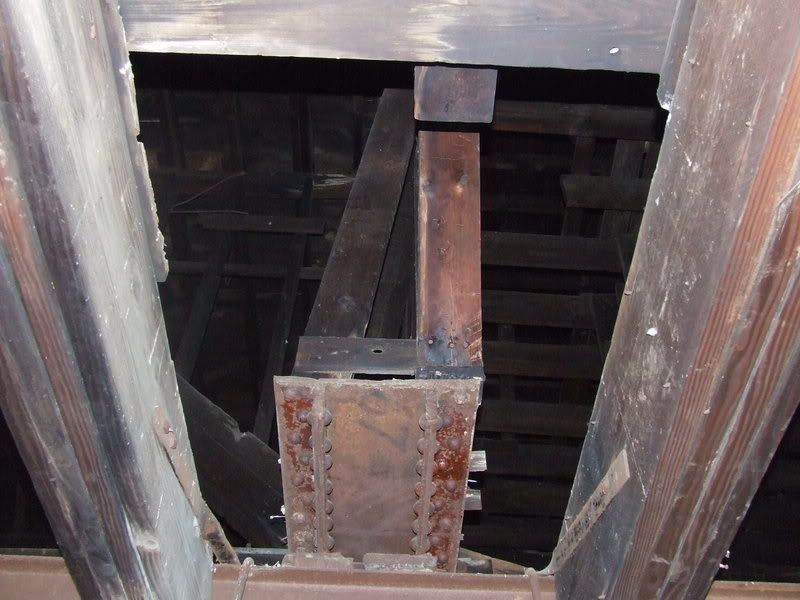
One of the best features of this trip was that some of the rigging equipment was still in existence. The first picture is of some of the sheeves.
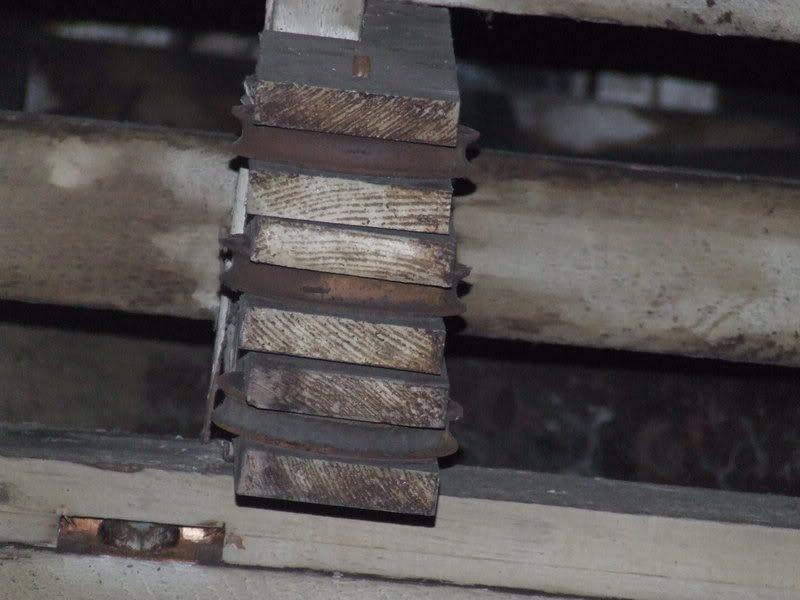 The beam shown in the next picture was where we believe the linesets were operated. The wooden sheaves seem to be bolted through the grid and through the joists.
The beam shown in the next picture was where we believe the linesets were operated. The wooden sheaves seem to be bolted through the grid and through the joists. 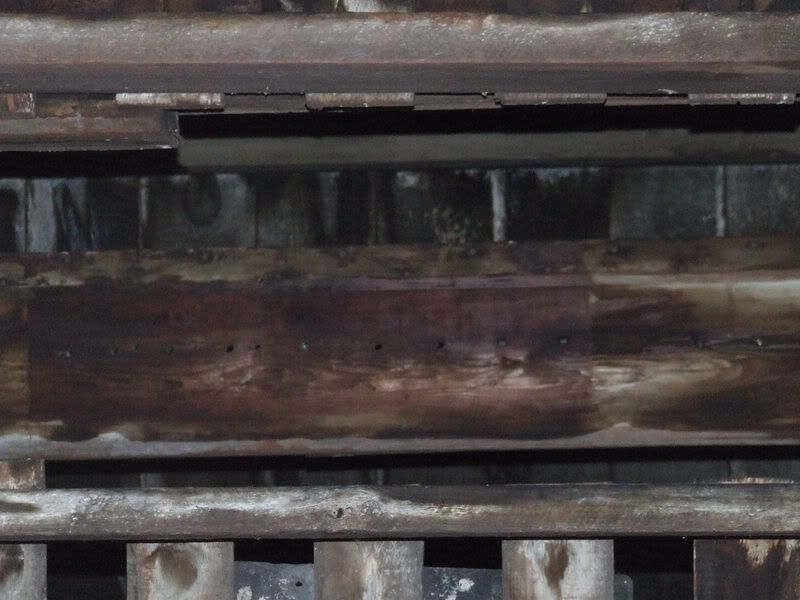
You can see these holes better from above the grid. There is ladder that goes up to this area of the building.
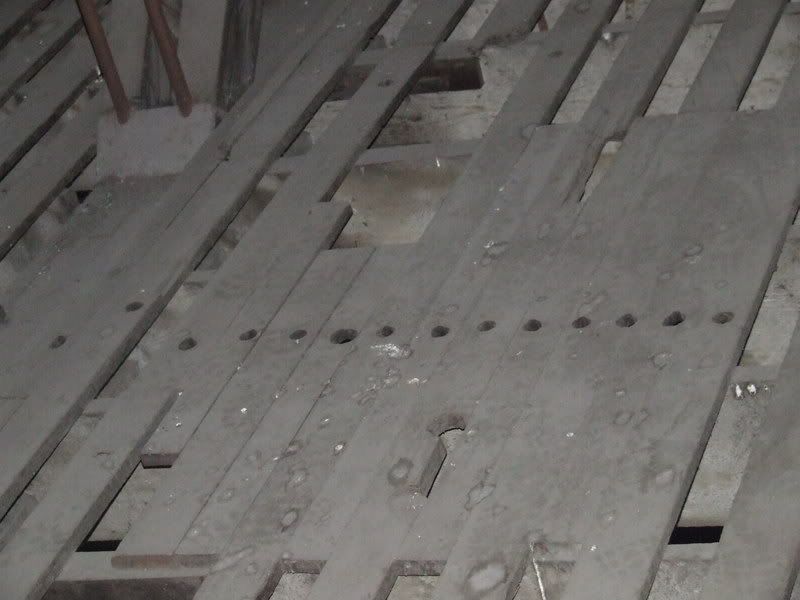
Below is a picture of the wiring box for the telephone.

The last picture is of the electrical boxes.
 the building was a fascinating look at old technology, it is a shame that it could not be saved or restored to the splendor that is obvious in its exterior architecture.
the building was a fascinating look at old technology, it is a shame that it could not be saved or restored to the splendor that is obvious in its exterior architecture.
Job Search Resources
Art Search through TCG is probably the biggest resource. While it is somewhat expensive, I have to admit that there is always a copy I can use somewhere in the company, so I don't routinely purchase the subscription.
Stagecraft mailing list (address in the resource blog) will sometimes post listings,
www.backstagejobs.com
This has been a great site for a number of years. You can now post a profile. And even better the profile works, I already made a contact through my profile.
http://www.theatrejobs.com/index.htm
A paid site-about 35 a year for a student, but that jumps to 75 for an individual. This used to be a free site, which I would often refer to, but I haven't been a member since they changed their policy. You can look at the job postings (title, and state), and these seem to correlate with ArtSearch. However, the site offers some services to job seekers (resume help, promotion, ect) if you are actively looking for work and had the dough this could be for you.
http://us.stagejobspro.com/welcome.php
I just joined this site so we will see how it goes. You fill out a description about yourself (basically your resume) and employers can search your information. You can also post pictures and your resume. Site is set up to be international, and is not very specific - there is not a TD category for instance, so I listed Technical Manager. You do have to have 3 professional jobs to list your profile.
http://www.theatrealliance.org/jobs/
jobs in the Philadelphia area.
http://www.theatre-service.com/services.htm
The company that is at USITT.
http://www.playbill.com/jobs/find/
Playbill, and yes, I have gotten a job from there, and hired from there.....
http://www.theatre-resources.net/
Has job services for summer work
http://www.eperformer.com/aud/tech.html
Has a few listing, but listing I have noticed in alot of other sites.
http://www.stagestaff.com/default.aspx
Another site I haven't registered for, but looks interesting.
http://www.simplyhired.com/
Not geared only to theatre, yet they do have tech theatre listings.
http://stagepros.com/index.php
http://www.indeed.com/jobs?q=Theatre&l=&from=osrss
http://www.stagespecs.com/jobs.cfm
SETC, and other conference sites often have job listings, as does USITT
Friday, March 23, 2007
TD Resources
The Stagecraft Mailing List
http://stagecraft.theprices.net/lists.html
This is one of may favorite sources of information. It is an active list, and the subscribers have a wide range of backgrounds. While the list does go off-topic occasionally, it is a great tool.
Yale Tech Briefs
http://www.yale.edu/drama/publications/index.html
While the information isn't available online, you can subscribe to it. If you are able, I would suggest finding the back issues, as there are alot of good ideas in the issues. each tech Brief is based off of a problem encountered in production, and a solution to solve the issue. There is also 2 volume set of technical solutions that pull from the tech briefs. While there were minor revisions for clarity, if you have the entire collection of tech briefs, the books would be repetitive.
USITT Tech Expo publications
Very similar to the Yale Tech Brief collection. Every other year USITT hosts a tech expo on which ideas are submitted and chosen that help create solutions to production challenges. The last edition came out a few weeks ago at the last USITT conference in Phoenix, AZ.
USITT Technical Production Commission
http://www.patrickimmel.com/usitt/techprod/tech_prod_index.htm
This site has 2 things of interest. First, they publish an online version tech briefs/tech expo types of solutions called the Technical Source Guide. Secondly, there are notes listed on the site from a few of the past USITT conference sessions.
Stage Directions
A magazine which you can subscribe to for free, now features a monthly column on technical direction and focuses on innovation solutions.
http://www.stage-directions.com/
TD&T
Also put out by USITT, this focuses on the wider industry, but has a range of information that is valuable to a TD.
http://www.theatrecrafts.com/
A website that has links for different areas of technical production. The amount of information varies by what you are looking for, but still a useful site to check out.
Theatre Crafts (magazine)
If you are connected to a university library you may be able to find an older publication called Theatre Crafts. They went through some minor changes, and older editions seem to be more useful than they newer versions, but it is still a valuable resource. This magazine became Theatre Crafts International, and then Entertainment Design
http://www.clarion.edu/library/theatrepathfinder.html
The above site talks about how to use the library for theatre research. While it is geared for a specific library, call numbers, the book and periodical lists are still very useful.
http://www.betsyda.com/etc/stagecraft.html
http://www.main.nc.us/openstudio/mta/techlnks.htm
These sites are a source of a variety of links to additional places to look for information.
http://www.hstech.org/index.php?option=com_frontpage&Itemid=1
This Site is run by Scott Parker, a member of the stagecraft mailing list. While geared for High School, there is some great information on the site.
Other magazines include:
Live Design, Lighting Dimensions, American Theatre
I am sure I have missed a few, but these are the major sources that I look at other than product catalogs, books, and material research . Let me know if I have neglected to mention a resource that you find useful.
Thursday, March 22, 2007
Visual Thinking and Problem Solving
At any rate, it often seems that problem solving visually is often practiced by scenic designers, and often not tended to as much by TDs (though they occasionally do it without thinking about it). This can be done in multiple ways, physically through the manipulation of items (mock ups, tests, models) or by drawings both by hand and in CAD. CAD in particular helps identify cable paths, fleet angles, travel paths and the like. If you draft in 3-d you can see the object from multiple views to check for errors that way. Layers can be adjusted and/or locked to plot only what is needed, while saving your work for future reference. It can be a powerful tool - and one I believe is underused.
While looking for more information on this topic I came across the following website:
http://code.arc.cmu.edu/creative/index.html
It has alot of good stuff. I particularly think that transferring shapes to flat pictorial drawings and back are useful to develop spacial / visual skills. It is ironic that in an age with such computer savvy-ness that spacial relationships are sometimes so hard to teach . Also on the above site if you go to the schedule section and then click on 'electronic reading pack' there are some good pdfs. I think a class like this would be interesting to teach, and if nothing else, could be an good intro to drafting.
Wednesday, March 21, 2007
House of Invention review
Tuesday, March 20, 2007
Planking
The material is a fiber compost - cement material. You do need special saw blades, as they dull regular blades very quickly. The plank is used for siding and the panel is used for flooring. It is good for waterproofing, and fireproofing. It paints well (it requires paint for finishing) and is very durable. It is less expensive than lumber and come in several different textures so it can simulate real planks.
In use it was found to be better than comparable OSB or hardboard products.
For more information:
http://www.jameshardie.com/
http://www.jameshardie.com/homeowner/prodcomp/default.php
Another product that was discussed was boxcar siding. Its basing stick lumber with tongue and grooves meant to be joined together for siding, often used in the older box cars. There are many types available (lumber, widths, ect).
For more information:
http://www.wrcla.org/cedar_products/cedar_siding/tongue_groove/default.htm
http://www.thepellco.com/Moldings/Tongue/TongueGroove.htm
Also, I should note that some of these materials are used for wainscoting.
Monday, March 19, 2007
USITT Part 2
At the Digital Swag Session these were some of the finds. A more complete list is available at the presenter’s homepage:
http://www.odu.edu/~kwinters/software/digital%20swag%20for%20the%20classroom.htm
Automation Sites:
http://workingmodel.design-simulation.com/
http://www.automationstudio.com/PRO/
http://thelearningpit.com/
http://www.alice.org/ a computer animation site
Drafting Programs
Sketch Up
A9CAD
AlleyCAD
Others:
http://www.paul-pelletier.com/LDCalculator/LDCalculatorPage.htm Mostly has lighting calculations, but includes some rigging information
http://www.celtx.com/ planning software as well as storyboarding
www.heatshrink.com
http://www.wepalmer.com/guidesbags.html they do fire curtains and borders, but the cable guides caught my eye.
Thursday, March 15, 2007
USITT Day 1

This is the display that has been keeping me so busy - the portal actually lights up - I put LED's in the inside of the frame. As always for me, I am already thinking of how I can prep for the next display, and make the process (build and load-in) easier, as well as maintaining my design choices after a trip through the airport.
Anyway, to move on... Most of my first day (wed) at Usitt was registering, doing the job search thing, and installing my display. However, I did manage to checkout Stump the TD. They busted a few myths, and then took questions from the audience about technical problems they had incurred. There were a few good ones, and a few not so good questions, but I suppose that it to be expexted.
One question was: a bird needed to fly up, then be shot, then fall and hit the ground. However, it was an outdoor venue with no "roof". Answers ranged from disguizing a remote control helicopter to spring loaded birds to using the element of distraction.
My question was that I needed a piece of aircraft cable to be rigged horizontally, with a curtain that changes positions, that needed to fly out on a lineset, and not have deflection. They suggested I hand the designer a book on physics. At least I negotiated my way out of the unit at the time! Though we did talk about the potencial for trussing, but it would be costly, and time consuming.
At one point they said that a TD's job requires 2 skills: Imagination and Negotiation.
Last but not least, some products that were mentioned:
Floor Strippeds - used for linolumn, put good for paint blobs as well:
http://www.interamericastage.com/
For information on Hazardous materials:
Quotes of the day
"When in doubt build it stout, with things you know about"
"How many TD's does it take to come up with 2 ideas? 1"
Sunday, March 11, 2007
LED Stars
 In this picture you can see the multiple strands of lights used. We ran the lights in odd patterns to try to eliminate the look of lines of stars. once the effect was installed and working, you could not tell which was one what line - they looked random between using the three different lines and the three different hole sizes.
In this picture you can see the multiple strands of lights used. We ran the lights in odd patterns to try to eliminate the look of lines of stars. once the effect was installed and working, you could not tell which was one what line - they looked random between using the three different lines and the three different hole sizes.  The picture below shows the header and stars being lifted into position so we could start the installation of the portal legs. We used Genie Tower lifts to raise the portals since there is not a fly system in this theatre space. You can also see that we only used some of the LED's. At the end of the cord we bundled up the remainder and put it in a bag to mask the light out put from the bundled LED's. In retrospect the only thing I would have changed would be to cover the rear of the portals with some masking because in the scene with the lowest amount of light the stars did bled somewhat on the front of the portal behind it.
The picture below shows the header and stars being lifted into position so we could start the installation of the portal legs. We used Genie Tower lifts to raise the portals since there is not a fly system in this theatre space. You can also see that we only used some of the LED's. At the end of the cord we bundled up the remainder and put it in a bag to mask the light out put from the bundled LED's. In retrospect the only thing I would have changed would be to cover the rear of the portals with some masking because in the scene with the lowest amount of light the stars did bled somewhat on the front of the portal behind it.  The below picture shows the final set. It doesn't do justice to the effect however. The LED's worked very nicely. The different sized drill holes was a great method of varying the stars.
The below picture shows the final set. It doesn't do justice to the effect however. The LED's worked very nicely. The different sized drill holes was a great method of varying the stars. 
*We purchased the lights from Noveltylights.com. The prices were competitive and shipping was low, and the service was fast. What more can you ask for in our line of business?
Saturday, March 10, 2007
Innovation
So what is innovation? What is the qualifiers? can the definition depend? Can it be innovative in a specific location, but within the industry as a whole? Theatre is innovative by default - how then, do you make it more so? I was looking at a vitae the other day that listed the development of a stagecraft class in a certain college as an innovation in teaching. While the class may have been an innovation for that specific college, introducing a stagecraft class now would be hardly innovative in the industry, or in colleges globally. Furthermore innovation in theatre is complicated by the fact that often the technique or method is being used in another industry prior to use in theatre. So it is innovative in the transfer of technique but not always in the development of the original technology.
Another challenge to innovation in technical theatre (especially props, paints and scenery) is tracking the history. Our innovation is constrained by show choice, style of production, and design choices, however, those could be innovators as well. Communicating what worked, and what didn't over time is very difficult in a theatre setting. We have several theatre magazines that can help track these ideas (TD&T, Stage Directions, Stagecraft list serve, Theatre Crafts, Yale Tech Briefs). Each of these (and other publications) have various advantages and disadvantages. Each of these usually focuses on a success, which is good, however, there are many factors that created that success that are under the surface. particular design choices, theatre setting, budgets, labor, available resources in the shop, time are just a few variables that mean that even these published successful ideas often requires adjustment.
The questions becomes is where does innovation start. How much does a process have to change to be innovative? How innovative must an idea/technique/object have to be to be acclaimed as innovative? Are their different levels that define innovation: is it different for individuals than for institutions? How can innovation be bench marked? How do you determine if it is innovative (research?). What quality standard must be made for an innovation?
There aren't easy answers, but I think that for an industry that is constantly evolving, they are necesssary questions to ask.
Friday, March 9, 2007
Shop Magnets
First is a product that operates very similarly - its main difference is reach since the tool is long and slender. It can be found at:
http://www.magneticindustrialproducts.com/retriever.html
The other links that I have for today are for various magnetic brooms. These are a great way to clean the shop or stage floor, as picking up all metal objects is as easy (actually perhaps even easier) as sweeping. They are similar to push brooms, except that they have a wheel on wither side of the "broom" and the broom is a magnet. The brooms are faster than the quick release, and are usually more thorough, particularly important when metal shavings need to be picked up. This is another tool that you should pick up for your shop.
http://www.magneticindustrialproducts.com/sweeper.html
http://magnetsinc.com/brooms_rakes/brooms.htm
http://www.ipesmag.com/mag_broom.htm
http://www.magnetclean.com/magneticpushbroom.html
http://www.ipesmag.com/pushbroom.html
http://www.hotkey.net.au/~magic/broom.htm
Thursday, March 8, 2007
Rocks
http://www.fakerock.com/
This site sells pre-made fake rocks in several materials. many of their designs are created to hide something visually unappealing though they have other types as well (pet houses for example). They have a few tree stumps as well and they are able to custom make rocks for your unique purposes. While the rocks aren't inexpensive, depending on how close the audience is, and your financial and labor situations, this could be a possible solution.
http://www.replicationsunlimited.com/cutomrockfeatures_pond.htm
Much bigger scale for the rocks on this site, and I am sure the costs reflect that. Since they handle costs through quotes, I imagine that this would be a pricey option. However, the selection of what is available on this site is pretty interesting. What intrigued me the most was the tree and the flex bark that they sell. While rocks can be difficult, they usually turn out well in the long run. Realistic bark is difficult to make.
http://www.dekorraproducts.com/default.html
This company id most similar to the first, specializing in smaller rocks to hide eyesores. They are based in Wisconsin, though you can search for a local distributor (multiple came up for my location).
So, for the next show that comes along that has a pile of rocks, add rock shopping to your list of possible technical solutions.
Tuesday, March 6, 2007
The Art of Construction
These books also combine well with Structural Design for the Stage (Holden and Sammler), Invention by Design (Petroski) and the building big series of videos. With in this conglomeration of texts and videos there are similar repeat themes, and each build on similar ideas, examples, and locations.
Monday, March 5, 2007
Resource: Letters
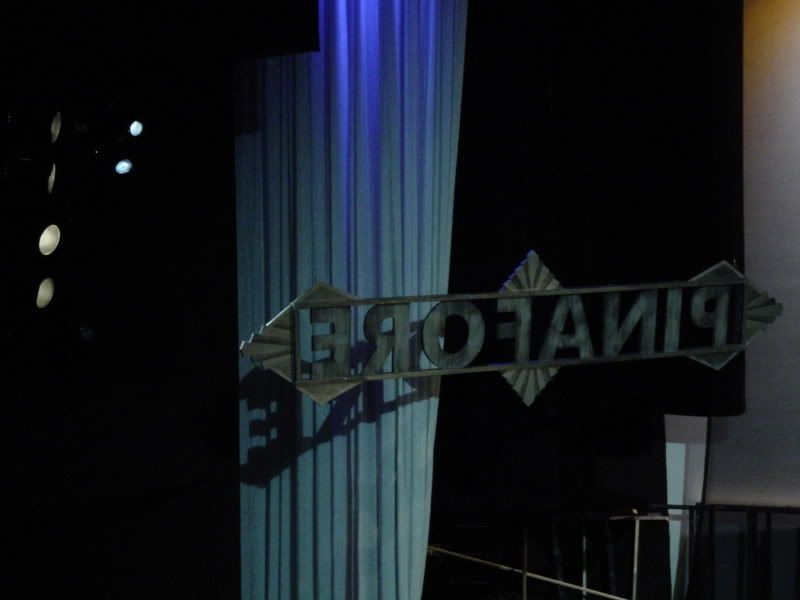
Sunday, March 4, 2007
Book Review: AutoCAD Onstage
Why, you may ask, am I reading a book about a drafting program that is currently coming out with yearly updates that is 17 years old? Well, honestly, when I first purchased the book I didn't pay attention, and it wasn't till I read the description on the first couple of pages about the computer system that it was truly obvious. But, I have other books from Rich Rose that are useful, and frankly I have an interest in the historical view of stagecraft. I thought that there might be some use in understanding the early start of AutoCAD, since many of the older commands are still buried within the program.
While obviously, many of the commands are easier to get to, and often more complicated (there seem to be more ways to enter a line for example), it is surprising what was around in the 1990 version of AutoCAD. It is interesting to note that while things are drafted in Full Scale, the limits, and such are all set up to be representative of 1 piece of paper, and each drawing would be 1 sheet. There are obviously alot of changes made in this area of AutoCAD. There are even a few commands that are still in AutoCAD today that I didn't know about! For instance, in the Undo command, you can type the number of step you want to back up, or you can mark the location. Once a position is marked, you can easily undo to this point.
I often use the clique that AutoCAD is like an iceberg, and that most users (particularly theatrical users) use only a very small part of what AutoCAD is capable of. It is interesting to note that within the book, even Rose alludes to that as well- he will point out several options of a command (such as Arc) and then list the other ways and tell the reader to play with these and learn them, but that they won't be as useful generally speaking, as the 2 methods he pointed out in the text.
While certainly, the Rich Rose text is too far out of date to actually learn the program from the book, it is useful to flip through and gain a sense of the history of CAD, and perhaps an insight into command development. First to understand current commands better, but also to understand why some commands still exist (limits for example, are no longer very useful, and relative and absolute entry aren't used directly as often today).
Book Review: The Memory Jogger 2
The book is available through Goal/QPC www.goalpc.com
The books is also available through services such as www.half.com
Friday, March 2, 2007
Platform Pneumatics
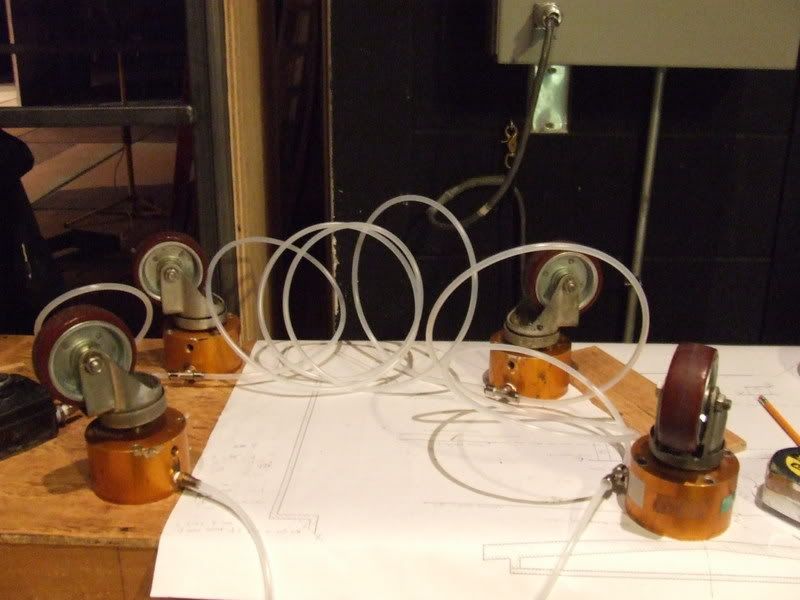 The above picture shows the cylinders with the hoses prepped. The hose ran from the tank (co2) and regulators through a valve that controlled the system then to each caster in a row. Since the shift happened at intermission we determined that the casters didn't have to fire at the same time so we ran the hose sequentially. The first three casters used Tee push in fittings (threaded to fit into the cylinder), and the last was a straight fitting. The air pressure was open, the regulator was adjusted to 80psi, and the valve was opened. The cylinders pushed the casters out, lifting the platform. The shift was performed. The air was turned off, the valve opened to exhaust the system and the weight of the platform pushed the casters back into the cylinders, setting the frame securely on the floor.
The above picture shows the cylinders with the hoses prepped. The hose ran from the tank (co2) and regulators through a valve that controlled the system then to each caster in a row. Since the shift happened at intermission we determined that the casters didn't have to fire at the same time so we ran the hose sequentially. The first three casters used Tee push in fittings (threaded to fit into the cylinder), and the last was a straight fitting. The air pressure was open, the regulator was adjusted to 80psi, and the valve was opened. The cylinders pushed the casters out, lifting the platform. The shift was performed. The air was turned off, the valve opened to exhaust the system and the weight of the platform pushed the casters back into the cylinders, setting the frame securely on the floor. 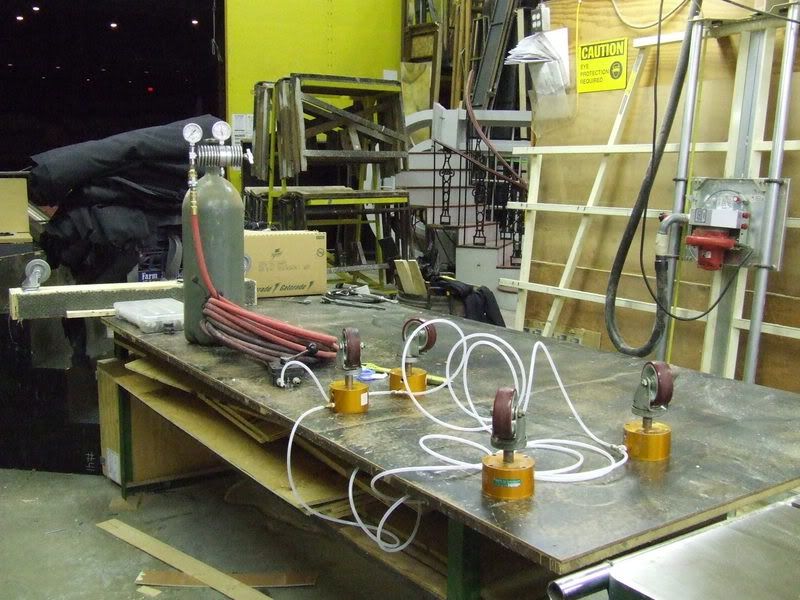 Above: The system set up in the shop.
Above: The system set up in the shop. Above: the platform with the system in process of installation.
Above: the platform with the system in process of installation. Above: interior view of installed system
Above: interior view of installed system
Above: exterior of platform with flats attached.
Quick Release Magnet
here is a link to one supplier:
http://www.leevalley.com/wood/page.aspx?c=2&p=32072&cat=1,42363,42356
The magnet basically attracts while it is in it's normal position, and you squeeze the handle to raise the magnet and release what you have picked up with it. very simple to use, and very effective.
Lee Valley, the vendor above which sells this contraption is one of my favorite non-theatrical vendors. They have good prices, high quality, and alot of useful and unique products. Surf their site and get a feel for what they have - their inventory has come in handy to me more than once in my career as a TD.
Google Docs & Spreadsheets
The advantage of Googles service seems to be:
You can create documents online (rather than only uploading them)
You can edit with others real time online
You can export your files in a variety of formats.
While Basecamp allowed others to edit, it wasn't real-time - it was controlled by version numbers. You could, therefore, potentially edit something at the same time causing errors.
Also, My biggest difficulty with Basecamp is the way that it exports. I can't use a web based pdf maker that uses the URL because it is a password protected site. The formatting is lost when I copy it into an office document. And their only export option is xml which I don't have the software to translate into something more usable. It allows you to archive it on the site, which is good, but leaves me with no soft copy of the project. I can easily download the files that where shared and revised - it is the to-do lists, messages and such that are more problematic.
Google, on the other hand, uses files for all activities - to-do lists, contacts ect. It is not specifically formatted to be a project management software, yet can be adapted into that quite easily. I also like that Google allows you to publish the file to a web page or a blog.
To learn more: http://docs.google.com/support/?hl=en
Insta-Snow Powder
Some other facts:
-It is slippery to walk on
-It is non-toxic (and 99% water)
-It can be used on any surface except untreated wood
-It feels cool to the touch
-The snow can be colored
-It can be used outside and on plant life
-Kids love it
1 pound runs about $35 and covers an area 20"x30"x4" deep (about 8 gallons of snow).
While this may never completely compete with plastic fake snow, I think it could be useful when the audience is very close, or for set dressing. There are some pieces of set dressing that never looks quite right, no matter what kind of fake snow is used. While the price is somewhat high depending on how much you would need, If you were careful to minimize losses, you could save a significant part of the powder for reuse.
To get more information check out the below link. The site also has some other great products as well.
http://www.stevespanglerscience.com/product/1262


